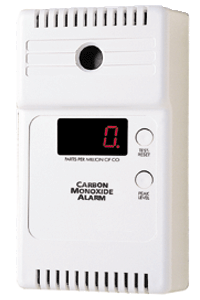 Carbon monoxide (CO) is an odorless, tasteless, invisible gas. According to the Journal of the American Medical Association, carbon monoxide poisoning is the leading cause of accidental poisoning deaths in America. Low levels of carbon monoxide poisoning cause symptoms similar to those of the flu or a cold, including shortness of breath on mild exertion, mild headaches, and nausea. Higher levels of poisoning lead to dizziness, mental confusion, severe headaches, nausea, and fainting on mild exertion. Ultimately, carbon monoxide poisoning can result in unconsciousness, permanent brain damage, and death.
Carbon monoxide (CO) is an odorless, tasteless, invisible gas. According to the Journal of the American Medical Association, carbon monoxide poisoning is the leading cause of accidental poisoning deaths in America. Low levels of carbon monoxide poisoning cause symptoms similar to those of the flu or a cold, including shortness of breath on mild exertion, mild headaches, and nausea. Higher levels of poisoning lead to dizziness, mental confusion, severe headaches, nausea, and fainting on mild exertion. Ultimately, carbon monoxide poisoning can result in unconsciousness, permanent brain damage, and death.
Average levels in homes without gas stoves vary from 0.5 to 5 parts per million (ppm). Levels near properly adjusted gas stoves are often 5 to 15 ppm and those near poorly adjusted stoves may be 30 ppm or higher. No standards for CO have been agreed upon for indoor air. The U.S. National Ambient Air Quality Standards for outdoor air are 9 ppm for 8 hours, and 35 ppm for 1 hour.
Carbon monoxide (CO) detectors are not substitutes for smoke detectors. Smoke detectors react to fire by-products, before CO detectors would alarm. Smoke detectors do not work as carbon monoxide detectors. Carbon monoxide can form in a house without causing a smoke detector to alarm.
Click here to read valuable information on carbon monoxide safety.
all single family homes to have a working carbon monoxide detector
installed within 10 feet of any bedroom.
Types Of Carbon Monoxide Detectors
When making a purchasing decision, be sure the unit you purchase conform to the latest Underwriters Laboratories UL2034 standards and includes the UL label. Any labeled CO detector offers adequate protection, but it’s vital that you follow the manufacturer’s recommendations for installation, testing and maintenance.
When purchasing, you must also consider how the CO detector is powered. They can be battery operated or powered by household current. Battery operated detectors are the easiest to install, and can be installed almost anywhere. Household current may eliminate the need to replace batteries, but may require an electrician to run power to where the smoke detector will be installed.
Some detectors include a digital display indicating what the CO level is. This feature will allow you to see changes in the CO level before a dangerous condition triggers the alarm.
The life of the CO detector you are evaluating must be a consideration. All CO detectors are electro-chemical devices. They use a chemical that reacts to carbon monoxide. The chemical needs to be replenished after a period of time. Most detectors will need to be replaced every two years. Some detectors have a sensor module that can be replaced instead of the whole detector. Other detectors are designed for a five year operating life.
Where To Place A Carbon Monoxide Detector
Follow manufacturer’s recommendations for placement in your home. If you are installing only one carbon monoxide detector, it should be located near the sleeping area, where it can wake you if you are asleep. Additional detectors on every level and in every bedroom of a home provides extra protection.
Because carbon monoxide is slightly lighter than air and also because it may be found with warm, rising air, detectors should be placed on a wall about 5 feet above the floor.
Do not install carbon monoxide detectors directly above or within fifteen feet fuel-burning appliances. Appliances may emit a small amount of carbon monoxide upon start-up. Avoid fireplaces and very humid areas such as bathrooms. CO Alarms should not be located in outlets covered by curtains or other obstructions. Do not place in turbulent air-near ceiling fans, heat vents, air conditioners, fresh air returns, or open windows. Blowing air may prevent CO from reaching the CO sensors. Keep the detector out of the way of pets and children.
Installing A Carbon Monoxide Detector
Carbon monoxide detectors are easy to install. Simply follow the manufacturer’s instructions. If a CO detector is mounted at or near the ceiling. Be sure to use a safe ladder to access the higher areas you may not be able to reach. A battery powered device normally requires you only have to secure the detector with a few screws. If you need assistance, ask a neighbor, relative, or the local fire department. If a smoke detector will be powered by household current, use a licensed electrician. You must also be sure that CO detectors powered by household current cannot be turned off by a wall switch.
Maintaining A Carbon Monoxide Detector
The biggest maintenance need is to ensure they are working properly on a regular basis. Get into a habit of checking them on a monthly basis, such as the first day of the month. Routine inspection should include:
- Check the alarm once a month by pressing the test button with your finger.
- Replace the batteries each Spring and Fall. Remind yourself to change the batteries when the clocks move ahead or back for Daylight Savings Time.
- Replace CO detectors according to the manufacturer’s instructions, usually about every two years.
Don’t forget to check you smoke detectors and fire extinguishers, too.
